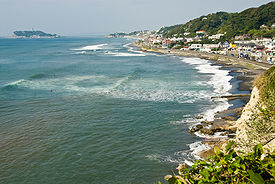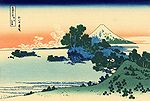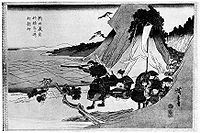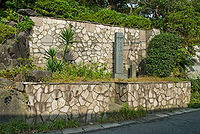
Shichirigahama
Encyclopedia

Kamakura, Kanagawa
is a city located in Kanagawa Prefecture, Japan, about south-south-west of Tokyo. It used to be also called .Although Kamakura proper is today rather small, it is often described in history books as a former de facto capital of Japan as the seat of the Shogunate and of the Regency during the...
, Kanagawa prefecture
Kanagawa Prefecture
is a prefecture located in the southern Kantō region of Japan. The capital is Yokohama. Kanagawa is part of the Greater Tokyo Area.-History:The prefecture has some archaeological sites going back to the Jōmon period...
, Japan, which goes from Koyurigimisaki Cape, near Fujisawa
Fujisawa, Kanagawa
is a city located in Kanagawa, Japan. As of 2010, the city had an estimated population of 407,731 and a population density of 5,870 people per km². The total area is 69.51 km²-Geography:...
, to Inamuragasaki
Inamuragasaki
is a cape at the western end of Yuigahama in Kamakura, Kanagawa Prefecture, Japan. The cape divides Yuigahama from Shichirigahama and Enoshima. Its name seems to stem from its shape, similar to a stack of rice at harvest time...
Cape, west of Kamakura. Since one could enjoy a clear view of Mount Fuji
Mount Fuji
is the highest mountain in Japan at . An active stratovolcano that last erupted in 1707–08, Mount Fuji lies about south-west of Tokyo, and can be seen from there on a clear day. Mount Fuji's exceptionally symmetrical cone is a well-known symbol of Japan and it is frequently depicted in art and...
and Enoshima
Enoshima
is a small island, about 4 km in circumference, at the mouth of the Katase River, which flows into Sagami Bay in Japan. Part of the city of Fujisawa, it is linked to the Katase section of the same city on the mainland by a 600 meter-long bridge...
from there, during the Edo period
Edo period
The , or , is a division of Japanese history which was ruled by the shoguns of the Tokugawa family, running from 1603 to 1868. The political entity of this period was the Tokugawa shogunate....
it was famous as a subject for ukiyo-e
Ukiyo-e
' is a genre of Japanese woodblock prints and paintings produced between the 17th and the 20th centuries, featuring motifs of landscapes, tales from history, the theatre, and pleasure quarters...
. For example, famous ukiyo-e artists Hiroshige
Hiroshige
was a Japanese ukiyo-e artist, and one of the last great artists in that tradition. He was also referred to as Andō Hiroshige and by the art name of Ichiyūsai Hiroshige ....
and Hokusai
Hokusai
was a Japanese artist, ukiyo-e painter and printmaker of the Edo period. He was influenced by such painters as Sesshu, and other styles of Chinese painting...
both include it in their 36 Views of Mount Fuji
36 Views of Mount Fuji
Thirty-six Views of Mount Fuji is a series of woodblock prints by the 19th-century Japanese artist Hokusai.Thirty-six Views of Mount Fuji may also refer to:...
. Its dark sands are rich in iron ore which allowed Kamakura to become a florid center for the production of swords and knives. Unlike its easterly neighbor Yuigahama
Yuigahama
is a beach near Kamakura, a city in Kanagawa Prefecture, Japan. The relation between the beach and its neighboring areas is complex. Although Yuigahama is in fact the entire 3.2 km beach that goes from Inamuragasaki, which separates it from Shichirigahama, to Zaimokuza's Iijima cape, which...
, because its floor drops too quickly, it isn't very popular as a sea resort, but surfers are present in every season. Since 1939 it is administratively part of the City of Kamakura. The area is served by the Enoshima Electric Railway
Enoshima Electric Railway
The connects Kamakura Station in Kamakura, with Fujisawa Station in Fujisawa, Kanagawa Prefecture, Japan. Stations en route include Hase Station, the stop closest to Kōtoku-in, the temple with the colossal outdoor statue of Amida Buddha. It is fully owned by the Odakyu Group of companies.- Train...
, or Enoden, which connects Kamakura Station
Kamakura Station
is a railway station in Kamakura, Kanagawa, Japan, operated by East Japan Railway Company .-Lines:Kamakura Station is served by the Yokosuka Line and Shōnan-Shinjuku Line. It is located 4.5 km from the junction at Ōfuna Station, and 53.9 km from Tokyo Station...
in Kamakura with Fujisawa Station
Fujisawa Station
is a major railway station in Fujisawa, Kanagawa, Japan. It is served by the Tōkaidō Main Line, Odakyu Enoshima Line, and the Enoshima Electric Railway. Clustered around the station are large department stores and office buildings, forming the center of the city...
.
Etymology of the name

Shinpen Kamakurashi
The is an Edo period compendium of topographic, geographic and demographic data concerning the city of Kamakura, Kanagawa Prefecture, Japan, and its vicinities. Consisting of eight volumes and commissioned in 1685 by Tokugawa Mitsukuni to three vassals, it contains for example information about...
, it comes from the (a term usually shortened into just Shichiri), which was an Edo period messenger service on the Kantōdō highway with a horseman change every seven "ri". However, since the expression shichiri also meant "a long ride", the name could also just mean that the beach is very long. Shichirigahama has also been called , and .
History
Although not part of Kamakura proper since it lies outside the city's Seven EntrancesKamakura's Seven Entrances
The city of Kamakura, Kanagawa in Japan, is closed off on three sides by very steep hills and on the fourth by the sea: before the construction of several modern tunnels and roads, the so-called Seven Entrances , or were its main links to the rest of the world...
, the entire area from Katase
Katase
Katase is a village in Alajõe Parish, Ida-Viru County, in northeastern Estonia. It's located on the northern shore of Lake Peipus. Katase has a population of 75 .Katase was first mentioned in 1419....
to Inamuragasaki
Inamuragasaki
is a cape at the western end of Yuigahama in Kamakura, Kanagawa Prefecture, Japan. The cape divides Yuigahama from Shichirigahama and Enoshima. Its name seems to stem from its shape, similar to a stack of rice at harvest time...
represents a historically important area just outside the former military capital. According to the Azuma Kagami
Azuma Kagami
The , or "mirror of the east", is a Japanese medieval text that chronicles events of the Kamakura Shogunate from Minamoto no Yoritomo's rebellion against the Taira clan in Izokuni of 1180 to Munetaka Shinnō and his return to Kyoto in 1266...
and the Shinpen Kamakurashi, Shichirigahama was the Kamakura shogunate
Kamakura shogunate
The Kamakura shogunate was a military dictatorship in Japan headed by the shoguns from 1185 to 1333. It was based in Kamakura. The Kamakura period draws its name from the capital of the shogunate...
's execution ground. It was also the scene of many battles, and records show that in the Edo period
Edo period
The , or , is a division of Japanese history which was ruled by the shoguns of the Tokugawa family, running from 1603 to 1868. The political entity of this period was the Tokugawa shogunate....
bones and rusty weapons were still being recovered from its sand.
Minamoto no Yoshitsune's letter from Koshigoe
Minamoto no YoritomoMinamoto no Yoritomo
was the founder and the first shogun of the Kamakura Shogunate of Japan. He ruled from 1192 until 1199.-Early life and exile :Yoritomo was the third son of Minamoto no Yoshitomo, heir of the Minamoto clan, and his official wife, a daughter of Fujiwara no Suenori, who was a member of the...
's famous younger half-brother Yoshitsune, celebrated in Japan in Noh
Noh
, or - derived from the Sino-Japanese word for "skill" or "talent" - is a major form of classical Japanese musical drama that has been performed since the 14th century. Many characters are masked, with men playing male and female roles. Traditionally, a Noh "performance day" lasts all day and...
and Kabuki
Kabuki
is classical Japanese dance-drama. Kabuki theatre is known for the stylization of its drama and for the elaborate make-up worn by some of its performers.The individual kanji characters, from left to right, mean sing , dance , and skill...
plays for both his bravery and his death, served the shogun
Shogun
A was one of the hereditary military dictators of Japan from 1192 to 1867. In this period, the shoguns, or their shikken regents , were the de facto rulers of Japan though they were nominally appointed by the emperor...
faithfully for years, leading the Minamoto clan
Minamoto clan
was one of the surnames bestowed by the Emperors of Japan upon members of the imperial family who were demoted into the ranks of the nobility. The practice was most prevalent during the Heian Period , although its last occurrence was during the Sengoku Era. The Taira were another such offshoot of...
in defeating the Taira clan
Taira clan
The was a major Japanese clan of samurai in historical Japan.In reference to Japanese history, along with Minamoto, Taira was a hereditary clan name bestowed by the emperors of the Heian Period to certain ex-members of the imperial family when they became subjects...
, but for several reasons couldn't avoid a confrontation with him. After some victories, he tried to enter Kamakura, but was stopped at Koshigoe
Koshigoe
is a part of the municipality of Kamakura, Kanagawa prefecture, Japan, located at the western end of the beach of Shichirigahama, near Fujisawa. The name seems to stem from the fact it was founded by people who crossed the base of the mountains to reach the fertile plains near the sea.This small...
by a letter from Hōjō Tokimasa
Hojo Tokimasa
was the first Hōjō shikken of the Kamakura bakufu and head of the Hōjō clan. He was shikken from the death of Minamoto no Yoritomo in 1199 until his abdication in 1205.- Background: The Hōjō Clan :...
. He waited fruitlessly about 20 days at Koshigoe's Manpuku-ji, near Shichirigahama, then dictated to his attendant Benkei a letter for Yoritomo destined to become famous, the "Letter from Koshigoe", in which he complained that he had never betrayed his brother, but to the contrary had always faithfully served him. He had won for him important victories, but had received nothing but reproach and diffidence in return. Yoritomo didn't relent, so Yoshitsune gave up and left Koshigoe for Kyoto.
The letter originally appears in the Azuma Kagami and is not believed to have been penned by Yoshitsune. It probably does however reflect his true feelings.
The feud between brothers continued until a fugitive Yoshitsune was forced to kill himself. His six-week old head preserved in liquor was then brought to the shogun, who accepted it in Koshigoe
Koshigoe
is a part of the municipality of Kamakura, Kanagawa prefecture, Japan, located at the western end of the beach of Shichirigahama, near Fujisawa. The name seems to stem from the fact it was founded by people who crossed the base of the mountains to reach the fertile plains near the sea.This small...
in 1182. Yoshitsune is enshrined in Shirahata Jinja in Fujisawa.
Inamuragasaki

Nitta Yoshisada
was the head of the Nitta family in the early fourteenth century, and supported the Southern Court of Emperor Go-Daigo in the Nanboku-chō period, capturing Kamakura from the Hōjō clan in 1333....
in 1333 invaded Kamakura, deposing its Regent Hōjō Takatoki
Hojo Takatoki
Hōjō Takatoki was the last Tokuso and ruling Shikken of Japan's Kamakura shogunate; the latter ones were his puppets, a member of the Hōjō clan, he was the son of Hōjō Sadatoki, and was preceded as shikken by Hōjō Morotoki.Takatoki became regent at the age of eight, and thus actual power was...
and ending the 145-year old Kamakura shogunate
Kamakura shogunate
The Kamakura shogunate was a military dictatorship in Japan headed by the shoguns from 1185 to 1333. It was based in Kamakura. The Kamakura period draws its name from the capital of the shogunate...
. According to the legend, being unable to defeat Kamakura defenses on land, he went down to Shichirigahama and, at the impassable cape of Inamuragasaki, prayed to the god Ryūjin
Ryujin
, also known as Ōwatatsumi, was the tutelary deity of the sea in Japanese mythology. This Japanese dragon symbolized the power of the ocean, had a large mouth, and was able to transform into a human shape. Ryūjin lived in Ryūgū-jō, his palace under the sea built out of red and white coral, from...
to withdraw the waves and let him through.
The stele at , the tiny bay west of Inamuragaki, reads:
666 years ago on May 21, 1333 Nitta Yoshisada, judging Kamakura's invasion on land to be difficult, decided to try to bypass this cape. This is the place where, according to tradition, he threw his golden sword into the waves, praying to the sea-god to withdraw them and let him pass.
(Stele erected in 1917)
Nichiren in Shichirigahama

Nichiren Buddhism
Nichiren Buddhism is a branch of Mahāyāna Buddhism based on the teachings of the 13th century Japanese monk Nichiren...
was born in Kamakura, and the city is rich in places tied to both Nichiren
Nichiren
Nichiren was a Buddhist monk who lived during the Kamakura period in Japan. Nichiren taught devotion to the Lotus Sutra, entitled Myōhō-Renge-Kyō in Japanese, as the exclusive means to attain enlightenment and the chanting of Nam-Myōhō-Renge-Kyō as the essential practice of the teaching...
and his life. Several of them are in Shichirigahama. This is because one of the shogunate's execution grounds was in Katase
Katase
Katase is a village in Alajõe Parish, Ida-Viru County, in northeastern Estonia. It's located on the northern shore of Lake Peipus. Katase has a population of 75 .Katase was first mentioned in 1419....
near Fujisawa in the spot where now Ryūkō-ji is, so, when Nichiren was condemned to death, he had to be brought there. Nichiren had been condemned for having written his Risshō Ankoku Ron, judged to be subversive by authorities. A miracle however saved him, because when he was about to be beheaded (an event known to Nichiren's followers as the ), lightning struck his executioner. Nichiren was ultimately pardoned and an order was sent to Katase to stop the execution.
Reikō-ji
and its were the scene of one of Nichiren's miracles. In a period of extreme drought, after the famous priest NinshōNinshō
was a Japanese Shingon Risshu priest during the Kamakura period. His was instrumental in reviving Ritsu Buddhism during this period, as well as establishing facilities to care for invalids. He was criticized by his contemporary Nichiren....
had already failed he successfully prayed the gods for rain. For this reason, the pond is also known as .
Nichiren's pine tree
The so-called was a pine tree on the road to Katase from which Nichiren hanged his kesa (a Buddhist stole) while on his way to Ryūkō-ji so that it wouldn't be soiled by his blood. The original pine tree died long ago, and has been replaced many times by the faithful. Today, however, there is no pine tree and only a stele is left.Yukiaibashi Bridge
The is a small bridge near Enoden's Shichirigahama's station built on the spot where a messenger carrying Nichiren's pardon met the messenger bound in the opposite direction to announce his miraculous salvation.Koyurugimisaki

One legend says that, during the Edo period, on it stood a pine tree which shook even when there was no wind, producing an extremely pleasant sound as if a celestial creature was playing an instrument. According to another, the founder of the shrine, who was a Kamakura period samurai called Sasaki Moritsuna, saw the pine tree move very slightly and emit sounds like those of a koto
Koto (musical instrument)
The koto is a traditional Japanese stringed musical instrument, similar to the Chinese guzheng, the Mongolian yatga, the Korean gayageum and the Vietnamese đàn tranh. The koto is the national instrument of Japan. Koto are about length, and made from kiri wood...
, so he gave the cape its name.
Nitta Yoshisada stopped at Koyurugi Jinja in 1333 to pray for victory. Having won, he came back to offer a sword and some money to the shrine, with which the shinden was later restored. The shrine used to be called from the name of Koshigoe's tutelary spirit , but its name was changed during the shinbutsu bunri
Shinbutsu Bunri
The term in Japanese indicates the forbidding by law of the amalgamation of kami and buddhas made during the Meiji Restoration. It also indicates the effort made by the Japanese government to create a clear division between native kami beliefs and Buddhism on one side, and Buddhist temples and...
(the forced separation of Buddhism and Shinto in temples and shrines) in the Meiji era. Later, in 1909, it was fused with another shrine, and for that reason it now enshrines kami
Kami
is the Japanese word for the spirits, natural forces, or essence in the Shinto faith. Although the word is sometimes translated as "god" or "deity", some Shinto scholars argue that such a translation can cause a misunderstanding of the term...
Takeminakata no Mikoto

